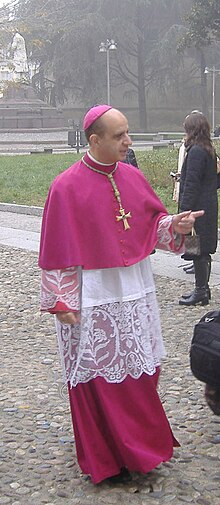Filet lace




Filet lace is the general word used for all the different techniques of embroidery on knotted net (or in French broderie sur filet noué). It is a hand made needlework created by weaving or embroidery using a long blunt needle and a thread on a ground of knotted net lace or filet work made of square or diagonal meshes of the same sizes or of different sizes. Lacis uses the same technique but is made on a ground of leno (a woven fabric) or small canvas (not a knotted lace), and the style known as Buratto is similarly on woven and not knotted foundations.[1]
History
[edit]
Filet lace is a form of decorative netting and as such can be presumed to have derived at some point from the fishnet that a community would require for fishing, hunting, transporting, etc. and not necessarily because they were living close to the water.
The Latin word filatorium is being used to describe filet lace then Jourdain (1904) quotes a reference to Exeter Cathedral possessing four pieces of filet lace in 1327. Latin word filatorium place for spinning, from filare to spin, from Latin filum a thread. (See filatory.) Ingram (1922) states that there was a "cushion of net-work in St. Paul's Cathedral so [sic] early as 1295." Such work, in the 14th century, was also described as "opus araneum".[2]
Filet-work is the result of knotting a fabric of diagonal or square meshes to create an open fabric called lace. The tool to make a knotted net lace is a shuttle-needle and a gauge stick for measure of the meshes.
The book Renaissance Patterns for Lace, Embroidery and Needlepoint, an unabridged facsimile of the Singuliers et nouveaux pourtraicts of 1587 by Federico de Vinciolo contains approximately 50 beautiful and well designed patterns which are suitable for filet lace-embroidery on knotted net using the linen stitch.
Technique
[edit]
As mentioned above, filet lace is created by doing embroidery stitches on a knotted net lace. The knotted ground lace can either be made by the lacemaker or as of 2003 purchased commercially in either handmade or machine-made varieties.
Making the net by hand with a shuttle needle and a gauge involves anchoring the piece, using either a heavy cushion (which Carità (1909) recommends be made of lead but should be replaced by sand or a C clip), a chair or a stirrup around the worker's foot. Having a secure anchor against which to maintain tension, a square net is made starting from one corner and adding a new mesh on each row until the desired size is reached, then by decreasing. The individual meshes are formed on a gauge which helps ensure a uniform size and are created by knotting to a loop in the previous round: square mesh, diagonal mesh, circular, free form. By using a very fine thread and different sizes of gauge one can create a beautiful and delicate lace work.
The knotted lace is then stretched on a frame and embroidery stitches are added using a long blunt needle and a thread. Patterns are designed on a grid with a mark for the meshes to be filled with the thread. A path (or direction) is traced on this pattern and then you follow this path with the needle on the ground lace.
When a group of certain stitches are used, the technique takes a name: filet Guipure, filet Richelieu, filet Soutache, linen stitch (point de toile), darning stitch (point de reprise); and then, when a region recognizes it, it may become French filet, filet di Bosa, filet Italien, filet de Gruyère, Russian filet Guipure, etc.
Many designs involve weaving the main design in linen stitch, indeed some designs consist entirely of linen stitch. This creates solid and open areas on the piece. A geometrical design or a sampler can use several different stitches, when a figural design will use very few stitches or only the linen stitch.
Filet lace is often seen in a single color of thread, usually white or ecru, but countries all over the world have used colored thread, precious metal threads, wool, feathers, etc.
References
[edit]- ^ Gwynne, Judyth L. (1997). The illustrated dictionary of lace (1. publ ed.). London: Batsford. ISBN 978-0-7134-7821-1.
- ^ "Filet lace (lace)". Encyclopædia Britannica. Encyclopædia Britannica Online. Retrieved February 11, 2013.
- Quinault, Marie-Jo (2003). Filet Lace: Introduction to the Linen Stitch Victoria, BC: Trafford. ISBN 1-4120-1549-9 is a book with patterns to learn the embroidery on a knotted net
- Carità (1909). Lacis. Sampson Low, Marston & Co.
- Th. de Dillmont (1923). Filet-Guipure. Mulhouse (Frankreich)
- Jourdain, M (1904). "Drawn Thread Work and Lacis". The Connoisseur. 10: 235–237.
- Ingram, Caroline Patience (1922). "'Point Compté' or Lace Netting". The Connoisseur. 62: 92–94.
- Vinciolo, Federico (1587). Les Singuliers et Nouveaux Pourtaicts
External links
[edit]- "Filet Lace by the Sea -- Supplies for Embroidery on a Filet Lace Net: Instruction, Patterns, Filet Nets, etc". Retrieved February 12, 2007.
- Quinault, Marie-Jo (2003). Instruction Book to Learn -- "Filet Lace, Introduction to the Linen Stitch" -- Item No. FL01. Trafford. ISBN 141201549-9. Retrieved August 8, 2014.
- "Starting Kit -- Complete kit with all the material, supply & accessories you need to learn and produce completely finished & functional pieces you'll be proud to show -- Item No. FL104". Retrieved August 8, 2014.
- Filet Lace – Virtual Museum of Textile Arts
- "Filet-Guipure (Part 1)" (PDF). Filet-Guipure [Filet Lace], Th de Dillmont, 1923. Retrieved June 2, 2005.
- "Filet-Guipure (Part 2)" (PDF). Filet-Guipure [Filet Lace], Th de Dillmont, 1923. Retrieved June 2, 2005.
- "Vinciolo" (PDF). I Singolari e Nuovi Disegni 1606 (1909 facsimile). Retrieved June 2, 2005.
- "Digital Archive of Documents Related to Lace". University of Arizona. Retrieved June 13, 2005.

